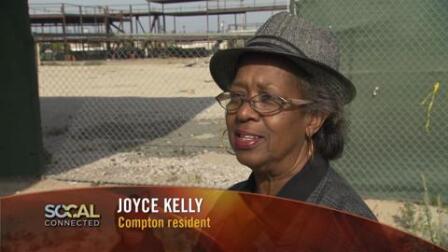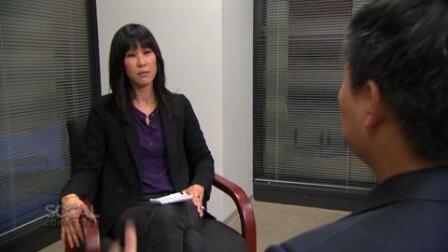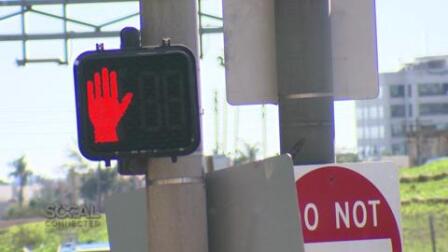As Bike Lanes Expand, Some Fear Traffic Will Only Get Worse

In L.A., who rules the road, cars or bicycles? While the answer may seem obvious, the bikes may be pulling ahead, at least on paper. A comprehensive plan is evolving that would create special bike lanes all over L.A. But as Dina Demetrius found out, not everyone is on board.
TRANSCRIPT
Dina Demetrius: Forget about Beverly Hills, Holmby Hills, or Los Feliz. For most Angelenos, the most precious, in-demand real estate in the city are the streets we get around on every day, and that includes by two wheels.
Don "Roadblock" Ward/Cyclist, Wolfpack Hustle: My, how do you say it, nom de bike is Roadblock. A cycling enthusiast. A livable streets enthusiast.
Demetrius: Don Ward has been pedaling through the streets of Los Angeles for nine years, using his bike to get nearly anywhere he wants to go. Cycling has now become a way of life for him, so much so that the underground bike rides he organizes have made him a minor celebrity among cyclists and one of their biggest activists. At 6-foot-8, and with a nickname like "Roadblock," few things frighten Ward, but a hit-and-run a few years ago put careless and angry drivers at the top of that list.
Ward: I was hit by an alleged drunk driver a few years back, who left the scene, left me for dead in the middle of the street.
Demetrius: That scene has been repeated often on L.A. Streets, with drivers hitting bike riders, and sometimes leaving them. In one recent incident, dragging the cyclist for 600 feet, causing him to lose his leg. It's heightened an already palpable "us vs. them" dynamic between drivers and cyclists.
Ward: When you're on a bike, you're way more alert. And somebody zooming up behind you is so threatening, that as a bike rider, I kind of interpret that as a threat, versus, "Oh, this person doesn't realize they're a threat to me," you know? So there's definitely an "us vs. them" in that sense.
Demetrius: Ward has become a vocal advocate of installing more bike lanes in Los Angeles to make riders feel safer. And he's not the only one. The city council has been hearing pleas for bike lanes for years. So in 2010, the city passed its most comprehensive and ambitious bikeway plan. So ambitious, it'll take 30 years to cover the 1,684 miles of planned bikeways from one end of L.A. to the other.
Ward: This time around, there's been enough pitch forks at City Hall to, I think, that they are actually making an effort to implement it.
Nate Baird/Bicycle Coordinator, LADOT: Our 2010 bike plan was very visionary. And so it was very important to our advocates that our bike plan go much farther than others had before, and that we also implement it.
Demetrius: Nate Baird is the bicycle coordinator for the Los Angeles Department of Transportation. As a cyclist who rides to work himself, he says laying down the vast network of new bike lanes in L.A. is necessary to allow for more biking over driving.
Baird: We've definitely seen more people bicycling as we've put in bike lanes. A key research study that's been done that shows people judge the entire trip by the worst part of the trip. And until you have a network in place, you're not going to have many trips that support these types of folks. Something like 40 to 60 percent of people would love to be able to ride their bike to work, but they don't feel comfortable riding on a street that doesn't have bike lanes.
Demetrius: Advocates say it will decrease pollution over time. But the main goal of adding these lanes is to make L.A. streets safe for all types of commuters. Right now, while cyclists are subject to the same rules of the road as drivers, they can also weave through traffic, being smaller and more mobile, like Ward here, cruising right past our news van on Los Feliz Boulevard.
Ward: I have to stay five to six feet away from parked cars because of the doors. People get out of the car, they swing open the door, you hit the door and you fly into the street and you die. So I'm gonna be riding in the lane. A lot of times weaving is safer.
Demetrius: And Baird says that's why a comprehensive network of bike lanes on busy L.A. streets is so important.
Baird: Bicyclists learn very quickly that it's important to just be in the middle of the lane in a lot of instances, especially in an urban environment. Being in the middle of the lane is the safest place to be because you're most visible there. But a lot of folks just aren't comfortable riding in the middle of the street. And you do get heckled as a bicyclist when you take the lane when you need to. So, it kind of benefits everybody to have your own clearly designated space on the street.
Demetrius: In the past two years, LADOT installed 123 miles of new bikeways, with the plan calling for 200 new miles being laid down every five years. The majority of those new pathways are lanes on L.A. streets, streets where cars rule the road. And it's been fairly drama-free adding bike lanes on neighborhood side streets for the last couple of years. But LADOT has now hit a critical point in the plan: they're ready to add bike lanes to L.A.'s main thoroughfares throughout the city, what they call "the backbone." And depending on what area of the city they're being laid down, some L.A. drivers are nowhere near ready for that.
Unidentified Driver: I think it's crazy! They can ride in the sidewalk.
Unidentified Resident: When it takes away a whole lane for cars, and especially in rush hour traffic, we need it. I've seen a couple of streets that now have bike lanes, and the traffic's gotten even worse.
Baird: We have this kind of big vision and then a process to take the little steps forward that we need to take. And that's what we've been doing. We've been doing kind of baby step after baby step. We've done all the easy bike lanes. Where we can fit them, we've put them in. And so now is really the time to start having these tougher conversations about our really major streets.
Demetrius: Bike lanes in the Silver Lake area are among the oldest and most traveled here in L.A. And residents here on the east side are happy to see them extend into downtown, with proposed bike lanes running past Dodger Stadium and through the Second Street tunnel. Meanwhile, over on the west side, it's a different story, where enthusiasm for these lanes becomes deflated...and downright aggravated, as Colleen Mason-Heller describes it. During Friday afternoon traffic, we talked about LADOT's plan to add a bike lane on southbound Westwood Boulevard.
Colleen Mason-Heller/Westside Neighborhood Council: This is the main artery from UCLA. And at any time during the day, it can back up for blocks and blocks. At this particular time of day, as approaching peak period, it backs up all the way to Olympic, to Santa Monica Boulevard and beyond. It's basically a parking lot.
Demetrius: Mason-Heller is the mobility chairperson of the Westside Neighborhood Council, which has been vocal in community hearings about the area's proposed bike lanes. She says on this major L.A. street already bulging with cars, dedicating one of two lanes to bikes will spell disaster for commuters and businesses, as well as biker safety.
Mason-Heller: If they take away a traffic lane, what we are looking at is a potential for increased congestion that has no remedy, because congestion will not decrease. And if you reduce capacity, that congestion is just squeezed into smaller areas. So you're just looking at absolute stalling. It increases driver frustration. So when you have drivers who are frustrated, you're likely to see them cut in and out of the bike lanes to get where they think they have a right to go. So it's a combustible mix.
Demetrius: On the west side, the plan calls for bikes lanes on four major north-south routes: Westwood Boulevard, Sepulveda Boulevard, the Bundy/Centinela area, and Avenue of the Stars in Century City, all heavily traveled streets for motorists and buses. At a February bike lane hearing in Westwood, Heller-Mason and her neighbors made it clear they didn't think the current plan was worth the added pain to a majority of commuters.
Mason-Heller: I can tell you that most people live more than three miles from their jobs in this area. This is not all local traffic. You're looking at .67 of all transit trips are by bicycle. So we heard when we went to the meeting that, "Well, all these bike paths will double the number of bike riders!" Then you're looking at still less than 2 percent of all transit riders, and yet they're going to take up an entire lane.
Demetrius: L.A. City Councilman Paul Koretz represents much of the west side, including the Westwood area. He's advocated more bike lanes for years.
Paul Koretz/L.A. City Council member: We're in desperate need of alternatives to the automobile to help reduce traffic in the City of Los Angeles.
Demetrius: But Koretz has found out his constituents can be as persistent as L.A. traffic, saying it's been a difficult process at times to balance the needs of different neighborhoods with implementing a citywide plan.
Koretz: We're getting feedback in both directions. The cyclists are happy to see all the north-south streets used. In Century City, there's some problems with easy access to the hotels because those hotels are a big chunk of the economic lifeblood of Century City, and we're not trying to do harm to the business community while we improve bicycle circulation.
Demetrius: So Koretz wants to pull back from the current westside plan. He sent a letter in March to LADOT asking them to "proceed with proposed bicycle lanes on Sepulveda, and delay implementation on Avenue of the Stars and Westwood Boulevard," saying that traffic "delays and parking loss along Westwood is unacceptable." LADOT will have to come up with alternative streets or designs in that area.
LADOT's Nate Baird says that bike lanes there are inevitable, but they are working with council offices to make some changes because of neighborhood concerns. But he believes what really needs to change is how people think about commuting.
Baird: There's going to be some costs involved. We can't continue to use our streets in the same way we always have. And so we know that adding bike lanes on these streets is going to have to change how we use these streets. They're not going to be able to use the same capacity that they had before. We're not going to be able to move the same amount of cars on these streets as we did previously. That's why we have to go through the hearing process.
Demetrius: And the long-term question still remains: If you build it, will they come? Koretz says "yes" -- sort of.
Koretz: I don't think it's worth it for the number of people that are riding bicycles now. But if we really have a system that's viable, and people feel safe to get on their bicycles, I think for the number of people that will ride in the future, I think it's absolutely worth it.
Demetrius: So this is an investment in the future?
Koretz: It absolutely is an investment in the future.
Demetrius: And trusting that people will change their commuting ways. That's a future Don Ward hopes will stretch well beyond the streets of Los Angeles.
Ward: If we could redesign our streets just a little bit to accommodate human beings and have the public space be free for everybody to use, not just car drivers, I think it would transform America, you know?











